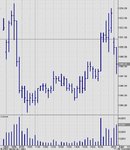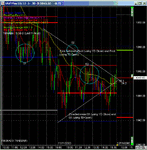just a quote from Mr T. Wood - I wud not comment on this personally. makes a rather tickling reading. 🙂
quote:
As I read about the Bull and Bear markets of the late 1800s and very
early 1900s, it becomes apparent that the Bull markets Mr. Dow wrote
about were the upward movements of the 4-year cycle and the Bear
markets were the downward movements of the 4-year cycle.
As our country became more and more sophisticated and more people
started investing, the Bull and Bear periods became longer. Bull and
Bear markets evolved into a series of multiple 4-year cycle periods.
For example, the Bull market from 1921 to 1929 was a period of two 4-
year cycles. The low in November 1929 was a 4-year cycle low. The
rally, "Secondary Reaction," that followed was the upside of
a 4-year
cycle that topped in only 5 months. Again, any top that has occurred
in 20 months or less has historically taken out the previous 4-year
cycle low. Once this "Secondary Reaction" was over, the DJIA
moved
down below the previous 4-year cycle low and into the 1932 4-year
cycle low, which proved to be the Bear market bottom.
I would also like to point out the 1921 to 1929 Bull market advanced
a total of 568% from the 1921 4-year cycle low at 67 on the DJIA to
the 1929 4-year cycle top at a high of 381 on the DJIA.
The next great Bull market began with the 4-year cycle low in 1942
and ran to the 4-year cycle top in 1966. This time the
"Primary" Bull
market comprised a series of six 4-year cycles. The Bear market that
followed was also a series of 4-year cycles. From the 1966 4-year
cycle top, the Bear market moved down into the 1974 Bear market low.
This was a series of two 4-year cycles.
The second great Bull market advanced a total of 1,076% from the 1942
4-year cycle low at 93 on the DJIA to the 1966 4-year cycle top at a
high of 1,001 on the DJIA. The bear market that followed ran from the
1966 high to the 1974 4-year cycle low at 570 on the DJIA.
From a cyclical perspective, the last and Greatest Bull market of all
time began with the 1974 4-year cycle low and ran to the recent 4-
year cycle top in January 2000. This "Primary" Bull market
comprised
a series of seven 4-year cycles.
This Great Bull market advanced a total of 2,061% from the 1974 4-
year cycle low of 570 on the DJIA to the January 2000 high of 11,750
DJIA. I can assure you; this Great Bear market is just beginning.
How Long Will The Bear Market Last?
As you can see, each Bull and Bear market has been a longer series of
4-year cycles and the percentage advancement of each Bull market has
been roughly double the previous Bull market's percentage
advancement. The Bear markets have indeed lengthened in terms of the
series of the number of 4-year cycles as well.
Now, I want to focus on the Bear market declines. The 1921 to 1929
Bull market was 8 years in duration and the 1929 to 1932 Bear market
was 3 years. The Bear market duration was 37.5% of the preceding Bull
market. The 1942 to 1966 Bull market was 24 years in duration and the
1966 to 1974 Bear market was 8 years. This Bear market duration was
33.3% of the preceding Bull market. The last Bull market ran from
1974 to 2000 and was 26 years in duration. Some argue that the last
Bull market began in 1982. I understand that argument, however, from
a cyclical perspective the Bull market began in 1974. 1982 was when
the Bull market broke out and became apparent. The point I am trying
to make obvious here is that this Bear market is just beginning. It
was not over with the October 2002 low. Based on the relationships of
the Bull and Bear markets of the past we are not very likely to see
the bottom of this Bear market before 2008 and possibly as late as
2010. I say 2008 because that would be roughly 33% of the duration of
the preceding Bull market. A bottom in 2010 would be closer to the
37.5% decline seen with the first Bear market. From a Cyclical
perspective, this Bear market will have to end with a 4-year cycle
low. I would say that we should expect the bottom with either the
2006 4-year cycle low and possibly not until the 2010 4-year cycle
low.
How Low Could it Go?
My minimum price objective for this Bear market based on my technical
studies take the S&P 500 down to approximately 315 and the DJIA down
to about 3,000. These targets are also confirmed if I apply a
fundamental measure, based on historical P.E. ratios. Let me explain.
At bear market bottoms P.E. ratios a found to be roughly equal to the
dividend yields. For example, in 1932 the yield on the S&P 500 was
10.50 with a P.E. just under 10. In 1942 the yield was 8.71 with a
P.E. of 7.3. In 1974 the yield was 5.9 and the P.E. was 7.24. In 1982
the yield was 6.2 and the P.E. was 6.9. Today the yield on the S&P is
1.7 and the P.E. is 30. Based on today's earnings a P.E. or 10
would
take the S&P 500 down to 348. In order for the S&P 500 to produce a
yield of 6% it would have to sell at 292 while a yield 8% would mean
that the S&P 500 would sell at 219. I know most people are probably
saying, "no way that will happen" and that is exactly what I
heard
back in 2001 when I was calling for a decline into the mid 7,000
range in late 2002. I can assure you this bear market is NOT over and
this forecast is highly probable.
Tim W. Wood, CPA
Editor, Cycles News & Views



